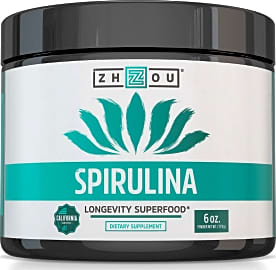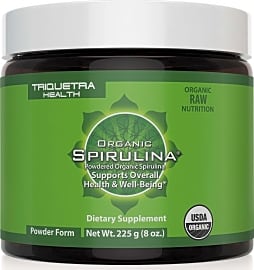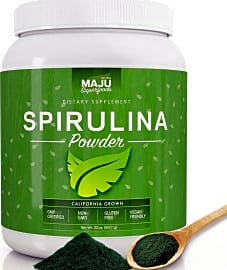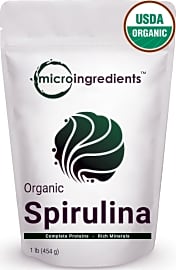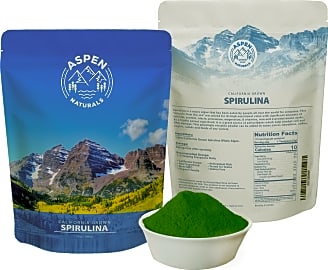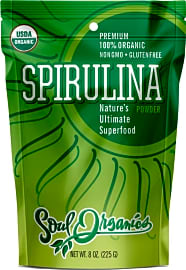The 10 Best Spirulina Powders

This wiki has been updated 34 times since it was first published in February of 2017. Spirulina users claim it can lower blood pressure, speed up weight loss, and even fight certain types of cancer. But eating the bacteria straight from a lake would be inadvisable — unless you're a flamingo — so we found powder forms that are extremely pure and easy to mix in your smoothies, juice, or water, making it simple to reap the benefits of this so-called superfood. When users buy our independently chosen editorial choices, we may earn commissions to help fund the Wiki.
Editor's Notes
June 04, 2019:
In this update, we've proudly witnessed our top 10 choices stand the test of time, continuing to reign supreme over the market's other current options. Our top pick, Nutrex Hawaii, continues to provide unsurpassed purity. We also appreciate its various size offerings, including a small 5 ounce option, which may appeal to those new to spirulina who are hoping to give it a trial run.
We prioritized sustainability and purity in our top picks, placing less importance on cost. While we are not ignorant to a consumer's desire to score a good deal, we surmised that most people seeking out such a supplement were health-conscious, and likely willing to spend a bit more for ethically-harvested, sustainably-raised, high-quality spirulina. Further, the difference in price between the costliest and the cheapest options isn't that large, anyway.
The biggest change we made was bumping Terrasoul Superfoods from #5 to #10. This has little to do with the product's quality, but more so with its packaging, which can occasionally cause a cloud of powder to burst out of the bag into the air, spattering your countertop with a green mess of powdered cyanobacteria.
Health Benefits Of Spirulina
It gets its green hue from a substance called phycocyanin, which fights free radicals and helps reduce inflammation.
If you've spent any time in a health food store recently, you've likely noticed this bright green powder showing up and wondered what all the commotion is around it. Health experts and enthusiasts alike can vouch for the stuff's many benefits. Spirulina is an edible cyanobacteria that tends to grow in masses in saltwater lakes and, once dried and mashed up, can be added to food and beverages so humans can reap its benefits. The stuff is extremely nutrient-packed — so much so that NASA has considered harvesting it in space to feed to astronauts. Just one tablespoon of the powder contains 15 percent of your daily vitamin B2 needs, which your body needs to break down carbohydrates and protein so it can turn them into energy. That same serving size gives you 21 percent of your daily copper needs, which helps your body absorb iron and produce collagen.
In addition to boasting tons of nutrients, spirulina can be very helpful to those with arthritis and other inflammatory conditions because it is high in anti-inflammatory antioxidants. It gets its green hue from a substance called phycocyanin, which fights free radicals and helps reduce inflammation. Its high levels of antioxidants can combat oxidative damage, which can affect our DNA and increase our chances of cancer and other diseases. If you're looking for new ways to add antioxidants to your diet but can't tolerate one more goji or blueberry, try infusing your smoothies with a little green powder.
If you add spirulina to your regular diet, your doctor may be happier with the results of your next round of bloodwork because it can improve cholesterol and blood sugar. It can be remarkably beneficial for those with diabetes for this reason. In fact, research has found that when those with Type-II diabetes consume just two grams of spirulina per day, their total cholesterol, triglycerides, and LDL cholesterol went down. Other studies have found that diabetics who consumed it regularly had lower levels of HbA1c, a high blood sugar marker. Even a small decrease in this can reduce the chances of death by diabetes substantially.
Unique Ways To Use Spirulina
Now that you're sold on eating more spirulina, you might be wondering exactly how you can incorporate it into your meals. It is impressively versatile, and you shouldn't struggle to find ways to add it to your favorite recipes. Spirulina does very well in blended drinks like smoothies. Try adding it to your pre-workout beverage for prolonged energy, mixing it with your protein powder shake after your workout, or incorporating it into your breakfast blender for a morning meal that holds you over for a while. It is great for diet-friendly smoothies too, as it adds a lot to the nutrient value without adding much to the caloric value.
If you want to double your antioxidant-eating efforts, try making dark chocolate brownies and adding this powder.
Spirulina works well in desserts, too, like brownies. If you want to double your antioxidant-eating efforts, try making dark chocolate brownies and adding this powder. Cacao seeds have been found to be higher in antioxidants than blueberries and acai berries. The rich flavor of dark chocolate blends with the taste of spirulina well. If you're feeling ambitious, you can even mix the green ingredient into your frosting for those brownies. Add it to your favorite vanilla frosting recipe for a dessert topping that has a beautiful lime green color — it's perfect for St. Patrick's Day celebrations or Earth Day treats.
If your family loves Mexican food, then you can sneak some spirulina onto their plates and get them to eat healthier, without them even knowing it. When making guacamole, add two teaspoons of spirulina for each one whole avocado, and prepare the rest of the recipe as you normally would. As for your burritos, swap out traditional white flour tortillas that are void of real nutrients and use spirulina wraps. Most health food stores will carry a brand or two of them, and they'll contain your beans, rice, cheese, and other fillings just as well as those unhealthy ones.
The History Of Spirulina
While spirulina is taking health food and supplement store shelves by storm, our generation is not the first to discover the stuff. Humans have relied on the powerful health perks of the food for a long time. In the 16th century, fisherman in the Aztec communities would collect green masses from a lake in their nets, and pound it into a cake. Some historians state that marathon runners from this group relied on spirulina to boost their performance. Eventually, many lakes in the region were drained to make room for agricultural and urban goals, but what still remains is Lake Texcoco, which still produces these healthful algae.
Botanist Jean Leonard determined that spirulina was at the base of African Dihé, and began making it in production facilities.
There wasn't much mention of the stuff by historians again until around 1940 when French phycologist Pierre Dangeard studied the Kanembu tribe of the African Lake Chad in Kanem. He found that this community would gather the algae in pots, drain the liquid with a cloth, and dry out the remainder in the sun. Eventually, women would form these into cakes and sell them at markets. These cakes were called Dihé, and the Kanembu members would crush them up, blend them into a sauce with tomatoes and peppers, and put that over fish or meat. Allegedly, pregnant women in this society believed that, by eating this food, they would protect their unborn children from sorcerers.
It wouldn't be until the 1960s that people found a way to grow these algae in a safe way, and produce it for mass consumption. Botanist Jean Leonard determined that spirulina was at the base of African Dihé, and began making it in production facilities. Today, over 22 countries produce the stuff and over 77 countries use it. It has been turned into oils, cosmetics, water purification tablets, and supplements.


